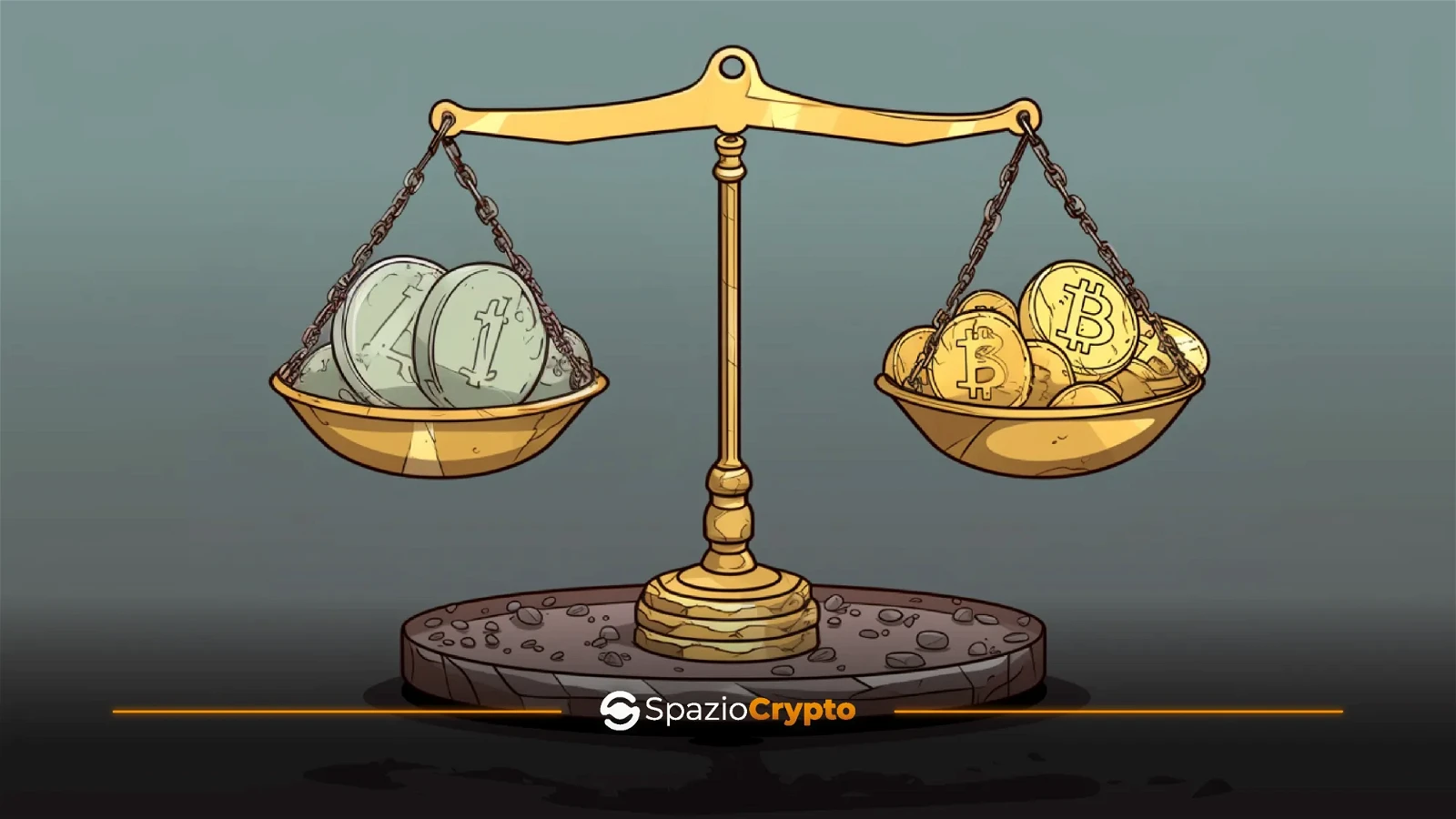In recent years, and especially in recent months, stablecoins have caught the attention of investors, financial institutions and regulators for their ability to combine the advantages of cryptocurrencies with the stability of traditional fiat assets.
But what exactly are stablecoins and how do they work?
Stillecoins represent a category of cryptocurrencies designed to maintain a stable value relative to an external unit of measure, such as a fiat currency like the US dollar or an asset like gold. This stability of value is achieved through various control and management mechanisms, which differ depending on the type of stablecoin. In general, stablecoins aim to provide users with greater reliability and predictability than the volatility typical of many other cryptocurrencies, allowing them to transact and store value more securely and efficiently.
In this Spaziocrypto article, we will explore the concept of stablecoins in detail, analysing their distinctive characteristics, the various types that exist, how they work and their uses. We will also uncover the challenges these cryptocurrencies may face and the potential impact they could have on the future of the global financial system.
How Do Stablecoins Work?
To fully understand how stablecoins work, it is essential to analyse the mechanisms that govern the stability of their value. Depending on the type of stablecoin, the underlying processes can vary significantly. Below, we will explore the main methods used to maintain the stability of stablecoins:
Flat-backed stabilisation
In the case of fiat-backed stablecoins, value stability is maintained through the maintenance of fiat currency reserves on a one-to-one basis. This means that each unit of stablecoin issued is backed by a corresponding unit of the reference fiat currency, usually held in a bank account or trust. When a user purchases or redeems stablecoin, the issuer can increase or decrease the amount of fiat currency held in reserve to maintain parity. This model is widely used by stablecoins such as Tether (USDT) and USD Coin (USDC).
Crypto-backed stablecoins
Crypto-backed stablecoins instead use cryptocurrencies such as Bitcoin or Ethereum as collateral to ensure stability of value. Users deposit a certain amount of cryptocurrency as collateral in a smart contract, which issues a corresponding amount of stablecoins. The value of these stablecoins is then determined by the value of the cryptocurrencies used as collateral. This model offers greater flexibility than fiat-backed stablecoins, allowing users to use their existing cryptocurrencies as collateral.
Algorithmic Stabilisation
Algorithmic stablecoins rely on algorithms and control mechanisms to adjust supply and demand in order to maintain stable value. These algorithms can employ various strategies, such as automatically adjusting supply according to demand or using economic incentives for market participants to help stabilise the price. However, this approach is more complex and can be subject to risks of market manipulation and sudden volatility if the control mechanism is not designed effectively.
In summary, stablecoins work by maintaining value stability through mechanisms such as fiat currency reserves, cryptocurrency collateral or supply adjustment algorithms. These tools provide users with greater reliability and predictability than traditional cryptocurrencies, allowing them to transact on the blockchain and store value more securely and efficiently.
Usages of stablecoins
Stablecoins have been adopted in a wide range of contexts and sectors due to their stability, security and ease of use. Let's look at some of the main uses and use cases of stablecoins:
International Money Transfers
Stablecoins offer an efficient and convenient method for making international money transfers. Due to the decentralised nature of the blockchain and the speed of transactions, stablecoins allow money to be sent around the world in minutes, with reduced costs compared to traditional money transfer services such as banks or payment companies.
Payments of Goods and Services
Stablecoins can be used to purchase goods and services online and offline, offering users a secure and stable alternative to traditional payment methods. Many platforms and online shops are starting to accept stablecoins as a form of payment, allowing users to transact quickly and conveniently without having to rely on banks or financial intermediaries.
Investment and Trading Tool
Stablecoins have also become animportant tool for investors and traders in the world of cryptocurrencies. Due to their stability, stablecoins can be used to protect profits and mitigate risk during periods of high market volatility. Trading platforms allow users to trade stablecoins with other cryptocurrencies and fiat currencies, offering profit opportunities through arbitrage and exploitation of price fluctuations.
Value Reserve and Inflation Protection
For individuals and communities living in countries with unstable economies or subject to high inflation, stablecoins can serve as a safe and stable store of value. By using stablecoins such as USDC or DAI, individuals can protect their purchasing power and access a stable alternative to national currencies that are subject to fluctuations and devaluations, as for example studied in Argentina and Venezuela.
Stablecoins, therefore, offer a wide range of uses and practical applications ranging from international financial transactions to inflation protection and cryptocurrency investments. Their adoption continues to grow, driving innovation in the financial sector and opening up new opportunities for individuals and businesses around the world.
Challenges and Criticalities
Despite the many advantages of stablecoins, there are also several challenges and criticalities that need to be considered. Let's examine some of the main obstacles and problems associated with stablecoins:
Centralisation Risk
Many stablecoins are issued and managed by centralised companies, which raises concerns about the centralisation of power and the possibility of market manipulation by a few actors. In addition, dependence on centralised entities may expose users to the risk of censorship and control by government authorities or the issuing companies themselves.
Regulatory and Legal Issues
Stillecoins are subject to a complex and changing regulatory and legal framework in many countries. The crypto regulatory authorities are still trying to fully understand how stablecoins work and to establish clear rules for their issuance, distribution and use. This regulatory uncertainty can hinder the adoption and expansion of stablecoins, limiting their potential for growth and development.
Vulnerability to Market Manipulation
Stablecoins can be subject to risks of market manipulation and fraud, especially those that depend on algorithmic mechanisms to maintain stable value. Malicious actors may attempt to manipulate the price of stablecoins through fraudulent trading or cyber-attacks on the underlying blockchain, putting the trust of investors and users at risk.
Technological and Operational Risks
Stablecoins are subject to a number of technological and operational risks, including errors in the code of the smart contract, cybersecurity vulnerabilities and exchange platform failures. These risks can lead to significant financial losses for users and damage the reputation of stablecoins as a whole.
In summary, while stablecoins offer a number of significant advantages, it is important to recognise and address the challenges and critical issues associated with these emerging cryptocurrencies. Only through a prudent approach and effective regulation can it be ensured that stablecoins can play a positive and constructive role in the future of the global financial system.
Case Study: Examples of Stablecoins
Examining some examples of stablecoins can offer further insight into the diversity and unique characteristics of these cryptocurrencies. Below, we will explore some of the main examples of stablecoins currently available on the market:
Tether (USDT)
Tether (USDT) is one of the most well-known and widely used stablecoins in the world. Launched in 2014, Tether is a fiat-backed stablecoin that is generally backed by the US dollar in a 1:1 ratio. Tether Limited, the company behind USDT, claims to maintain fiat currency reserves equivalent to the total value of USDT tokens issued. Tether is widely used as a medium of exchange and store of value in the cryptocurrency world, but has also sparked controversy regarding the transparency of its reserves and governance.
USD Coin (USDC)
USD Coin (USDC) is a fiat-backed stablecoin issued by a consortium of companies called Centre, which includes Circle and Coinbase. Similar to Tether, USDC is backed by the US dollar in a 1:1 ratio and its reserves are subject to regular audits to ensure transparency and regulatory compliance. USD Coin has been adopted by numerous cryptocurrency platforms and financial services to facilitate peer-to-peer payments and transactions.
Dai
Dai is a decentralised stablecoin issued on the Ethereum blockchain by the MakerDAO. Unlike Tether and USD Coin, Dai is a crypto-backed stablecoin, which means it is backed by a variety of cryptocurrencies deposited as collateral in a standalone smart contracts system called Maker Protocol. This makes Dai more resistant to censorship and market manipulation, as well as providing users with greater transparency and security. Dai is widely used as a store of value and trading tool in cryptocurrencies.
Stablecoin: The Future of Transactions?
Stablecoins represent a significant innovation in the world of cryptocurrencies and the global financial system. These stablecoins offer a number of advantages, including reduced volatility, ease of use in transactions and access to financial services. However, it is important to recognise that stablecoins are not without their challenges and critical issues, including centralisation risk, regulatory and legal issues, vulnerability to market manipulation, and technological and operational risks.
In spite of these challenges, the future of stablecoins looks promising, with growing interest from investors, financial institutions and regulators worldwide. However, for stablecoins to realise their full potential, it is crucial to address the challenges and critical issues associated with these emerging cryptocurrencies. This requires an ongoing commitment from developers, issuers, regulators and the community in ensuring the transparency, security and regulatory compliance of stablecoins and related ecosystems.
At Spaziocrypto, we are convinced that stablecoins represent an important step in the evolution of the global financial system, offering a new paradigm for storing and exchanging value in a secure, transparent and efficient manner. With the right approach and collaboration between all stakeholders, stablecoins have the potential to revolutionise the way people interact with money and financial services, opening up new opportunities for financial inclusion and economic growth around the world. Learn more in our Web3 Guide!








